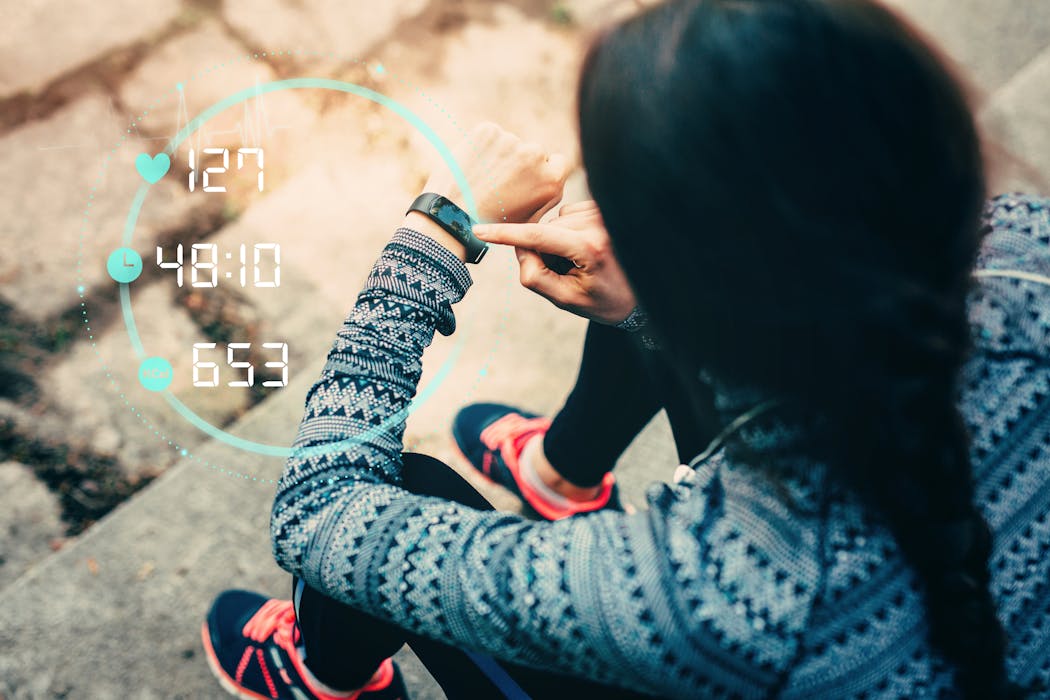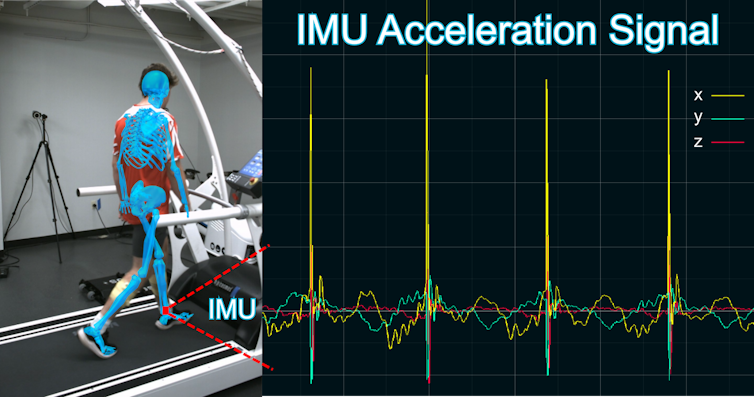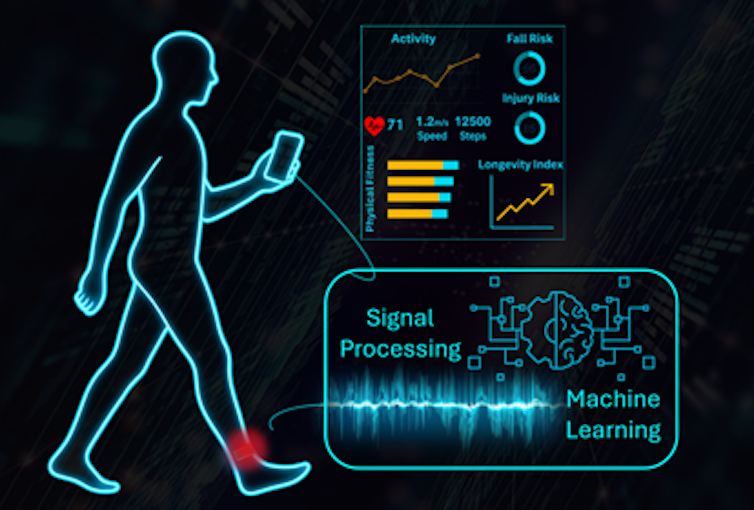Turning motion into medicine: How AI, motion capture and wearables can improve your health
- Written by Azarang Asadi, Data Scientist, Oklahoma State University
 The use of motion data is expanding from fitness and rehabilitation to general health.Todor Tsvetkov/E+ via Getty Images
The use of motion data is expanding from fitness and rehabilitation to general health.Todor Tsvetkov/E+ via Getty ImagesPeople often take walking for granted. We just move, one step after another, without ever thinking about what it takes to make that happen. Yet every single step is an extraordinary act of coordination, driven by precise timing between spinal cord, brain, nerves, muscles and joints.
Historically, people have used stopwatches, cameras or trained eyes to assess walking and its deficits. However, recent technological advances such as motion capture, wearable sensors and data science methods can record and quantify characteristics of step-by-step movement.
We are researchers who studybiomechanics andhuman performance. We and other researchers are increasingly applying this data to improve human movement. These insights not only help athletes of all stripes push their performance boundaries, but they also support movement recovery for patients through personalized feedback. Ultimately, motion could become another vital sign.
From motion data to performance insights
Researchers around the world combine physiology, biomechanics and data science to decode human movement. This interdisciplinary approach sets the stage for a new era where machine learning algorithms find patterns in human movement data collected by continuous monitoring, yielding insights that improve health.
It’s the same technology that powers your fitness tracker. For example, the inertial measurement unit in the Apple Watch records motion and derives metrics such as step count, stride length and cadence. Wearable sensors, such as inertial measurement units, record thousands of data points every second. The raw data reveals very little about a person’s movement. In fact, the data is so noisy and unstructured that it’s impossible to extract any meaningful insight.
 A study participant walks on a treadmill in our lab while a motion sensor attached to the subject’s ankle captures acceleration signals.Human Performance and Nutrition Research Institute
A study participant walks on a treadmill in our lab while a motion sensor attached to the subject’s ankle captures acceleration signals.Human Performance and Nutrition Research InstituteThat is where signal processing comes into play. A signal is simply a sequence of measurements tracked over time. Imagine putting an inertial measurement unit on your ankle. The device constantly tracks the ankle’s movement by measuring signals such as acceleration and rotation. These signals provide an overview of the motion and indicate how the body behaves. However, they often contain unwanted background noise that can blur the real picture.
With mathematical tools, researchers can filter out the noise and isolate the information that truly reflects how the body is performing. It’s like taking a blurry photo and using editing tools to make the picture clear. The process of cleaning and manipulating the signals is known as signal processing.
After processing the signals, researchers use machine learning techniques to transform them into interpretable metrics. Machine learning is a subfield of artificial intelligence that works by finding patterns and relationships in data. In the context of human movement, these tools can identify features of motion that correspond to key performance and health metrics.
For example, our team at the Human Performance and Nutrition Research Institute at Oklahoma State University estimated fitness capacity without requiring exhaustive physical tests or special equipment. Fitness capacity is how efficiently the body can perform physical activity. By combining biomechanics, signal processing and machine learning, we were able to estimate fitness capacity using data from just a few steps of our subjects’ walking.
Beyond fitness, walking data offers even deeper insights. Walking speed is a powerful indicator of longevity, and by tracking it, we could learn about people’s long-term health and life expectancy.
 Wearables capture motion signals, and through signal processing and machine learning, the data produces valuable health metrics such as risk of falling.Human Performance and Nutrition Research Institute
Wearables capture motion signals, and through signal processing and machine learning, the data produces valuable health metrics such as risk of falling.Human Performance and Nutrition Research InstituteFrom performance to medicine
The impact of these algorithms extends far beyond tracking performance such as steps and miles walked. They can be applied to support rehabilitation and prevent injuries. Our team is developing a machine learning algorithm to detect when an athlete is at an elevated risk of injury just by analyzing their body movement and detecting subtle changes.
Other scientists have used similar approaches to monitor motor control impairments following a stroke by continuously assessing how a patient’s walking patterns evolve, determining whether motor control is improving, or if the patient is compensating in any way that could lead to future injury.
Similar tools can also be used to inform treatment plans based on each patient’s specific needs, moving us closer to true personalized medicine. In Parkinson’s disease, these methods have been used to diagnose the condition, monitor its severity and detect episodes of walking difficulties to prompt cues to the patients to resume walking.
Others have used these techniques to design and control wearable assistive devices such as exoskeletons that improve mobility for people with physical disabilities by generating power at precisely timed intervals. In addition, researchers have evaluated movement strategies in military service members and found that those with poor biomechanics had a higher risk of injury. Others have used wrist-worn wearables to detect overuse injuries in service members. At their core, these innovations all have one goal: to restore and improve human movement.
Motion as a vital sign
We believe that the future of personalized medicine lies in dynamic monitoring. Every step, jump or squat carries information about how the body functions, performs and recovers. With advances in wearable technology, AI and cloud computing, real-time movement monitoring and biofeedback are likely to become a routine part of everyday life.
Imagine an athlete’s shoe that warns them before an injury occurs, clothing for the elderly that detects and prevents a fall before it occurs, or a smartwatch that detects early signs of stroke based on walking patterns. Combining biomechanics, signal processing and data science turns motion into a vital sign, a real-time reflection of your health and well-being.
Matthew Bird has previously received funding from the Department of Defense. The views expressed in this manuscript are those of the author and do not necessarily reflect the views, opinions, or policies of Oklahoma State University.
Azarang Asadi and Collin D. Bowersock do not work for, consult, own shares in or receive funding from any company or organization that would benefit from this article, and have disclosed no relevant affiliations beyond their academic appointment.
Authors: Azarang Asadi, Data Scientist, Oklahoma State University

